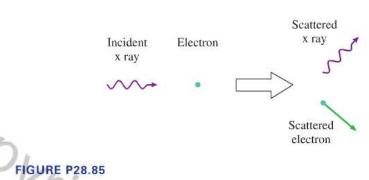When the (x)-ray photon scatters from the electron, A. Its speed increases. B. Its speed decreases. C.
Question:
When the \(x\)-ray photon scatters from the electron,
A. Its speed increases.
B. Its speed decreases.
C. Its speed stays the same.
Further support for the photon model of electromagnetic waves comes from Compton scattering, in which \(\mathrm{x}\) rays scatter from electrons, changing direction and frequency in the process. Classical electromagnetic wave theory cannot explain the change in frequency of the \(\mathrm{x}\) rays on scattering, but the photon model can.
Suppose an \(\mathrm{x}\)-ray photon is moving to the right. It has a collision with a slow-moving electron, as in Figure P28.85. The photon transfers energy and momentum to the electron, which recoils at a high speed. The \(\mathrm{x}\)-ray photon loses energy, and the photon energy formula \(E=h f\) tells us that its frequency must decrease. The collision looks very much like the collision between two particles.
Step by Step Answer:

College Physics A Strategic Approach
ISBN: 9780321907240
3rd Edition
Authors: Randall D. Knight, Brian Jones, Stuart Field





